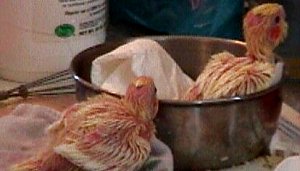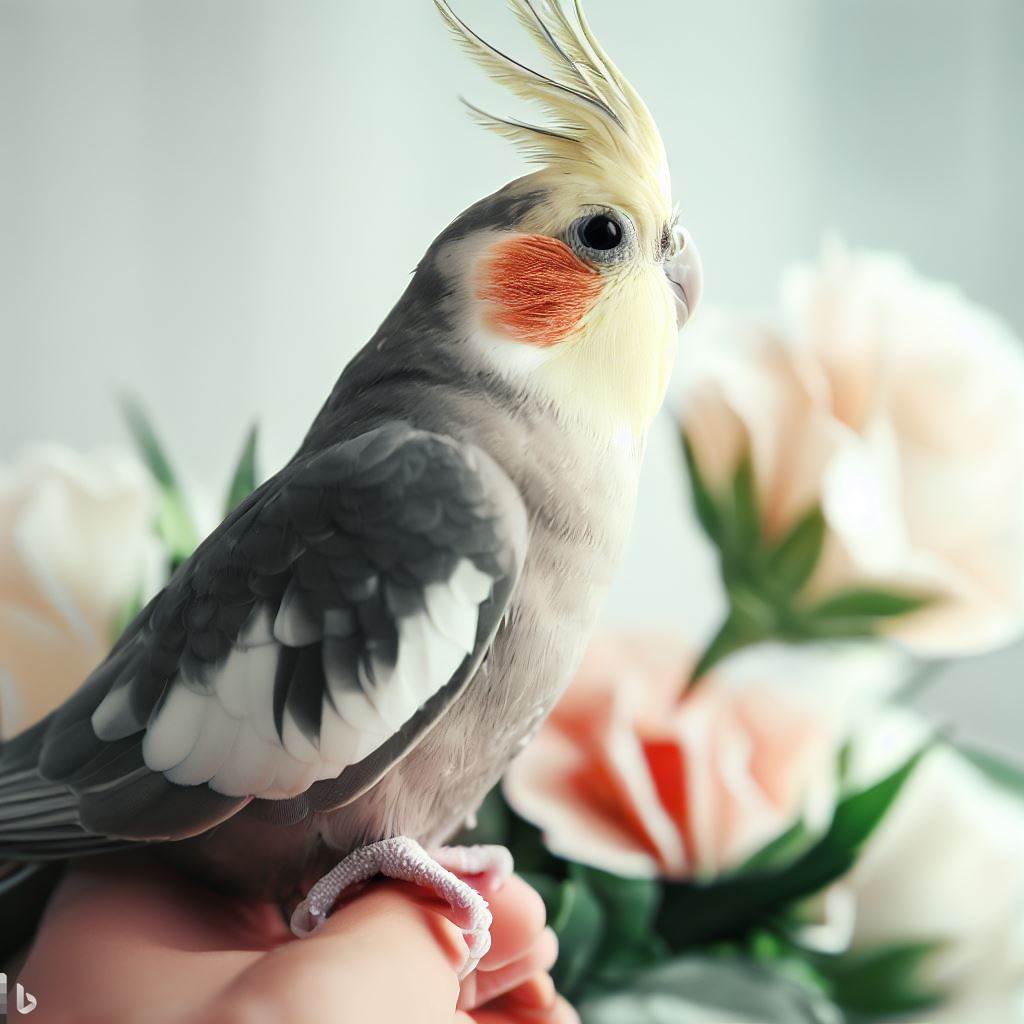
When do cockatiel chicks fledge?
Your cockatiels are three to four weeks of age and have stopped eating as much formula as they had been. You are alarmed that the chicks have cut back so much and worry that they aren’t getting the nutrition that is needed. This is what is known as the cockatiel pre-flight diet that every cockatiel goes on in preparation for its first solo flight. This normal process may panic the conscientious breeder who is concerned that the chick is starving to death. As the caretaker of the chicks, it is your responsibility to see that the chicks are getting enough food to support growth and sustain life. In order to accomodate the chicks, I find that it is easier to feed less volume in the syringe more often. The goal is to have the chicks eating 20-30cc/ml each day. This can be accomplished by feeding 5cc/ml four to six times a day. In this way you are able to meet the chicks nutritional needs as they prepare for their first flight.
Problems encountered in fledging
One of the problems which may be encountered is poor feather quality. Nutrition is vital to growing chicks. Nutritional deficits in the diet may delay muscle development in the wings, chest, and shoulders. A lack of protein for new feather development will delay the chick’s ability to fly. Chicks that are undernourished don’t have the energy and stamina required for flying. Everything the chick needs must be provided in the diet. Flying takes energy, muscles, and coordination.
A fledging chick’s main interest is flying, not eating. Giving the chick an opportunity to practice his flying skills before feeding him, will most likely result in his eating better.
Importance of flying
There are many things a cockatiel chick must learn as he is growing into an adult bird. One that is critical to the chick’s development is learning to fly. Birds have wings. It is important to the emotional health of the chick to master being able to fly and land safely. Flying increases the chicks self confidence and increases their sense of well being. One of the reasons for allowing chicks to learn flight is that they learn to control the flight and make safe landings.
Once the chick has had several successful solo flights where he has had a controlled flight with a safe landing, this is the time for the first baby clip.
Successful flight
What actually constitutes a successful flight? First it is a controlled flight, where the chick doesn’t bang into walls, windows, or furniture in the home. Second is a feet first landing at the spot where the chick has decided to land. The chick learns to make good decisions when flying and rapidly learns coordination, so as to judge how fast the chick is flying. It is not a drop like a rock, bouncing the chest off the floor or busting tail feathers as the bird lands. Several things can happen with an out of control landing. The chick may hurt his beak, bust his chest wide open requiring immediate emergency veterinary care or may cause injury to the area of the vent which requires stitches to repair the injury.
Hazards when flying
Our homes are not safe places for flighted cockatiel chicks. Some of the hazards to the chicks while learning flight are open windows, doors, toilet bowls, open pots on the stove, and multiple other kitchen hazards. The kitchen is a place of danger for a flighted chick. Chicks can fly out the door, drown in a glass of water or in a bathroom toilet, or suffer severe trauma injuries as a result of flying into a wall. I have had chicks land behind furniture in a very tight space and rescuing the chick is quite difficult. Since the chick is very fearful, he doesn’t cooperate to make rescuing him easier. Other chicks have landed in open paper bags from which they don’t have the strength or coordination to fly up and out of.
As a breeder, I can tell you of the panic that is felt when the chicks have flown and you can’t find one. Often the chick doesn’t make any noise, which increases the problem of finding the chick. There have been many cockatiel rescue operations in my home. You want to prepare your home for flighted chicks before they fledge. While there are hazards for the chicks, they still must learn to fly. It is important to their future self-confidence and emotional well-being.
Baby Wing Clips
Most cockatiel chicks will fledge between three to five weeks of age. They will do their very first solo flight at this time. If you are handfeeding, preparation for this event is critical. The chicks will be flapping their wings and cutting back on the amount of formula that they eat as the get ready to fly.
Once you realize the chicks are close to flying, you probably only want to bring one chick out at a time to handfeed him. Otherwise you will find all the chicks flying in five different directions. Since if this happens, you are unable to keep track of where each individual chick has landed, it is safer for the chicks who aren’t being fed to be housed in the brooder.
Baby clips are progressive
It is important to carefully look at the flight feathers to determine if any of the feathers are blood feathers. Feathers with a blood supply should never be cut, as this may cause the feather to bleed and may result in the emergency pulling of a blood feather.
Once you’ve established that there aren’t any blood feathers, you will want to cut the first two primary flight feathers on both wings. Make the cuts as symmetrical as possible. Too much variation will cause problems with the chick being able to control the flight and makes the chick off balance.
After this cut you want to allow the chick to learn to fly with this cut. It takes very little time for cockatiel chicks to adjust to the flight feather trim. Please always remember that chicks with flight feather trims can still fly. The cockatiel is one of the best fliers in the parrot world, so it’s important to remember that even though the wings have been trimmed, the cockatiel can still fly.
Once the chick has learned to control the flight and land with this flight feather cut, it is now time to cut two more primary flight feathers on each wing. This allows the chick to learn to control the speed of the flight and land on its feet without crashing the chest or vent on the floor. This progressive baby clip continues until eight to ten primary flight feathers have been cut on each wing. By doing this, the wing and chest muscles are developed and the chick’s coordination improves with each progressive clip.
Bad flight feather trims
A drastic flight feather trim, which goes into the coverts causes problems for the cockatiel chick. Usually the chick has not had any time to learn to fly, which means poor muscle mass in the chest, a lack of coordination and the inability to control flight or land safely. Most often with this drastic a cut, the chick will fly backwards, breaking off his tail feathers in landing and may injure the vent area to the point of needing stitches. When you have one that is flying backwards, you will want to allow the flight feathers to grow completely out and allow the bird to learn to fly the way he needed to when he was beginning to fledge. Using a progessive wing clip works with older birds who haven’t learned to fly and by doing this you will allow the tiel to develop his wing and chest muscles, thereby growing in confidence.
Other difficulties
Once the chicks have mastered the art of flying, it is all that they want to do. I’ve found that once I open the brooder, the chicks quickly fly to the top edge and perch there while awaiting their handfeeding formula. It is at this time, when they have had some experience, that they are likely to fly off on you. If you aren’t closely monitoring the chick you are in the process of handfeeding, he may take off in flight. Be sure your focus remains on him.
Cockatiel chicks who are fledging will diet to make themselves more areodynamic and often eat very little. It is at this time that the handfeeder must make certain that the chicks are receiving adequate nutrition. A cockatiel chick between three and six weeks needs about 20-30cc/ml of formula a day. I find it best to divide this into five or six small feedings of 5cc/ml. Although this may be considered a lot of feedings, the chicks seem to do well with this schedule.
Once the chicks are six weeks old, their appetite returns and they want more to eat in each feeding. It is only 2 to 4 weeks till the chicks are weaned and eating as independent adult cockatiels. Timing the full flight trim with weaning gives time for the chicks to mature physically, emotionally, and psychologically. One of the mistakes made is trying to rush the flight feather trim or weaning. This produces a chick that is insecure, fearful, and unwilling to bond with his human flock.
Conclusion
Flight is important to birds. Keeping them safe is our responsibility since we have chosen to bring them into our homes, which is an unnatural environment for them. A full flight feather trim enables the bird to glide gently to the floor or to fly short distances to the arm of their favorite person. This doesn’t mean that the cockatiel can’t fly away with a good updraft of wind. With the cockatiel’s awesome ability to fly, the bird can be 50-60 feet in the air in a matter of seconds.
Vigilance is important in keeping flighted birds safe, so once you notice an increased ability to get lift and fly for longer distances, it is time for a flight feather trim. Always remember to check feathers for blood supply. When the cockatiel molts, new feathers come in and you don’t want to cut one that has a blood supply.
I hope that this article will help to keep your cockatiel chicks safe. And that you will enjoy watching your chicks grow in confidence has they learn the art of flying. Flight is an awesome thing to watch and experience as you watch the chicks that you have nurtured growing into mature adult cockatiels.

